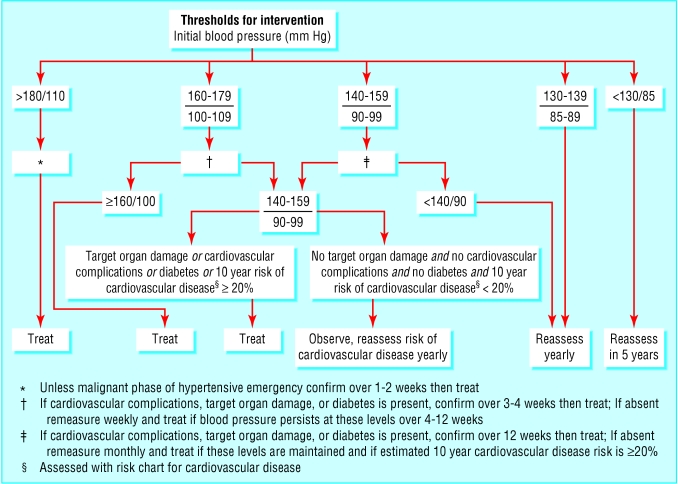Editor—If the new British Hypertension Society (BHS) guidelines1 are evidence based I'll eat my ALLHAT.2 This and other evidence points to thiazide-type diuretics as the initial treatment of choice. New US guidelines reflect this,3 but the BHS recommends a range of initial drug types for hypertension.
The BHS recommends primary prevention use of statins for those with sustained “starting” blood pressure > 140 mm Hg systolic or > 90 mm Hg diastolic, or both, and an estimated risk of cardiovascular disease > 20% over the next 10 years. The set target is to lower total cholesterol by 25% or low density lipoprotein cholesterol by 30% or to reach < 4.0 mmol/l or < 2.0 mmol/l respectively, whichever is the greater.
Figure 1.
Blood pressure thresholds for intervention
Where is the evidence? The BHS cites Scandinavian cardiac outcomes trial-lipid lowering arm (ASCOT-LLA)4 and the heart protection study.5 In ASCOT-LLA subjects were chosen with high risk and higher blood pressure (> 160/> 100 mm Hg), or treated hypertension (> 140/> 90 mm Hg).4 Most participants in the heart protection study had established vascular disease or diabetes.5 The effect of the set statin dose achieved an average total cholesterol of 4.2 mmol/l in ASCOT-LLA4; around 50% had higher cholesterol. These studies did not chase a cholesterol target. Thus the BHS encourages unproved, aggressive treatment.
These proposals beggar belief and could beggar the NHS: 20% of the adult population could be given both blood pressure drugs and high dose statins. Society needs to decide whether it wishes to medicalise risks that largely relate to poor lifestyle choices. There is a need for political decisions based on affordability. The BHS compounds its dodgy interpretation of the evidence by dodging the wider implications of its recommendations.
See editorial by Campbell
Competing interests: None declared.
References
- 1.Williams B, Poulter NR, Brown MJ, Davis M, McInnes GT, Potter JF, et al. British Hypertension Society guidelines for hypertension management 2004 (BHS-IV): summary. BMJ 2004;328: 634-40. (13 March.) [DOI] [PMC free article] [PubMed] [Google Scholar]
- 2.ALLHAT Officers and Coordinators for the ALLHAT Collaborative Research Group. Major outcomes in high-risk hypertensive patients randomized to angiotensin-converting enzyme inhibitor or calcium-channel blocker vs diuretic: the Antihypertensive and Lipid-Lowering Treatment to Prevent Heart Attack Trial (ALLHAT). JAMA 2002;288: 2981-997. [DOI] [PubMed] [Google Scholar]
- 3.Joint National Committee on Prevention, Detection, Evaluation, and Treatment of High Blood Pressure. The seventh report of the Joint National Committee on Prevention, Detection, Evaluation, and Treatment of High Blood Pressure (JNC VII). JAMA 2003;289: 2560-72. [DOI] [PubMed] [Google Scholar]
- 4.Sever PS, Dahlof B, Poulter NR, Wedel H, Beevers G, Caulfield M; ASCOT investigators. Prevention of coronary and stroke events with atorvastatin in hypertensive patients who have average or lower-than-average cholesterol concentrations, in the Anglo Scandinavian cardiac outcomes trial-lipid lowering arm (ASCOT-LLA): A multi-centre randomised controlled trial. Lancet 2003;361: 1149-58. [DOI] [PubMed] [Google Scholar]
- 5.Heart Protection Study Group. MRC/BHF heart protection study of cholesterol lowering with simvastatin in 20,536 high-risk individuals: a randomised placebo-controlled trial. Lancet 2002;360: 7-22. [DOI] [PubMed] [Google Scholar]



